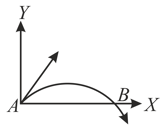Embibe Experts Solutions for Chapter: Kinematics, Exercise 14: Exercise (Analytical Questions)
Embibe Experts Physics Solutions for Exercise - Embibe Experts Solutions for Chapter: Kinematics, Exercise 14: Exercise (Analytical Questions)
Attempt the practice questions on Chapter 4: Kinematics, Exercise 14: Exercise (Analytical Questions) with hints and solutions to strengthen your understanding. Beta Question Bank for Medical: Physics solutions are prepared by Experienced Embibe Experts.
Questions from Embibe Experts Solutions for Chapter: Kinematics, Exercise 14: Exercise (Analytical Questions) with Hints & Solutions
A projectile is fired at an angle of with the horizontal. The elevation angle of the projectile at its highest point as seen from the point of projection is:
The motion of a particle along a straight line is described by the equation , where is in and in . The retardation of the particle when its velocity becomes zero is:
The horizontal range and the maximum height of a projectile are equal. The angle of projection of the projectile is:
A particle has initial velocity and acceleration . The magnitude of velocity after will be
A stone is dropped from a height . It hits the ground with a certain momentum . If the same stone is dropped from a height more than the previous height, the momentum when it hits the ground will change by
A stone falls freely under gravity. It covers distances , and in the first , the next and the next , respectively. The relation between , and is:
The velocity of a projectile at the initial point is . Its velocity (in ) at a point is:

A projectile is projected from the ground with initial velocity . If the acceleration due to gravity is along negative direction, then find the maximum displacement in direction.
